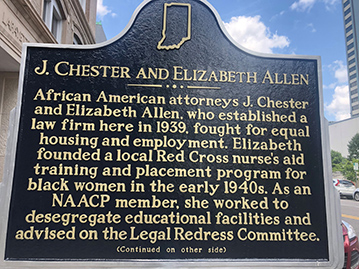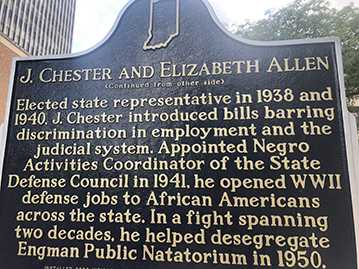

Location: 115 S. Lafayette Blvd., South Bend (St. Joseph County), Indiana 46601
Installed 2020 Indiana Historical Bureau, African American Fund of the Community Foundation of St. Joseph County, South Bend NAACP, and City of South Bend
ID#: 71.2020.2
Learn more about the Allens’ work for equality in the judicial system and World War II employment with the Indiana History Blog.
Text
Side One
African American attorneys J. Chester and Elizabeth Allen, who established a law firm here in 1939, fought for equal housing and employment. Elizabeth founded a local Red Cross nurse’s aid training and placement program for black women in the early 1940s. As an NAACP member, she worked to desegregate educational facilities and advised on the Legal Redress Committee.
Side Two
Elected state representative in 1938 and 1940, J. Chester introduced bills barring discrimination in employment and the judicial system. Appointed Negro Activities Coordinator of the State Defense Council in 1941, he opened WWII defense jobs to African Americans across the state. In a fight spanning two decades, he helped desegregate Engman Public Natatorium in 1950.
Annotated Text
Side One
African American attorneys J. Chester and Elizabeth Allen, who established a law firm here in 1939,[1] fought for equal housing and employment.[2] Elizabeth founded a local Red Cross nurse’s aid training and placement program for black women in the early 1940s.[3] As an NAACP member, she worked to desegregate educational facilities and advised on the Legal Redress Committee.[4]
Side Two
Elected state representative in 1938 and 1940, J. Chester introduced bills barring discrimination in employment and the judicial system.[5] Appointed Negro Activities Coordinator of the State Defense Council in 1941, he opened WWII defense jobs to African Americans across the state.[6] In a fight spanning two decades, he helped desegregate Engman Public Natatorium in 1950.[7]
All issues of The South Bend Tribune were accessed via Newspapers.com. All issues of the Indianapolis Recorder were accessed via Hoosier State Chronicles, unless otherwise specified.
[1] “Allen J Chester,” Polk’s South Bend (Indiana) City Directory, including Mishawaka (1930), (R. L. Polk & Co., Publishers), p. 93, accessed Ancestry Library.; The South Bend Tribune, November 25, 1931, 6.; “Lawyers,” Polk’s South Bend (St. Joseph County, Ind.) City Directory, including Mishawaka, (1939), (R. L. Polk & Co., Publishers), p. 844, accessed Ancestry Library.; “Announcements,” The South Bend Tribune, October 19, 1940, 1.; “1941-42 Classified Business and Professional Directory,” South Bend Mirror, August 29, 1941, 9, accessed Michiana Memory.; Alice Slade, “Area Women Lawyers Tell it ‘Like it Is,’” The South Bend Tribune, March 9, 1975, 67.
[2] “Housing Forum Set Thursday,” The South Bend Tribune, May 22, 1938, 5.; “Fight Renewed for Low-Cost Homes in City,” The South Bend Tribune, March 21, 1939, 13.; “Group to Visit Housing Meet,” The South Bend Tribune, September 22, 1939, 29.; “Job Democracy,” Indianapolis Recorder, February 15, 1941, 1, 6.; “Train for Defense Jobs: Select Men,” Indianapolis Recorder, October 11, 1941, 3.; “More Housing Sites Studied,” The South Bend Tribune, February 20, 1942, 21.; “Meeting Appeals for Assistance of Grant,” The South Bend Tribune, July 13, 1942, 10.; “War Jobs, Housing Sought by South Bend Citizens,” Indianapolis Recorder, July 25, 1942, 9.; “Watch Conduct and Stay on Job Workers Told,” Indianapolis Recorder, May 8, 1943, 1.; “Sites Chosen for 150 New Negro Homes,” The South Bend Tribune, December 11, 1943.; “Slum Project Fund is Sought,” The South Bend Tribune, February 9, 1945, 15.; “$1,605 Pledged to Homes Fund,” The South Bend Tribune, March 7, 1945, 12.; “Public Housing Boost Planned,” The South Bend Tribune, February 9, 1950, 23.; Lynn W. Turner and Heber P. Walker, Indiana at War: A Directory of Hoosier Civilians Who Held Positions of Responsibility in Official, Volunteer and Cooperating War-Time Organization (Bloomington: Indiana War History Commission, 1951), 500-501, accessed Google Books.; Lewis S. Haber, “Crowd Jams into Gallery for Hearing,” The South Bend Tribune, May 10, 1960, 15.; “500 B & P Women to Probe Negro’s Economic Status,” The Pittsburgh Courier, August 28, 1965, 1, 4, accessed Newspapers.com.; Program, “Leaders for Workshops on Three Areas Affecting the Urban Family,” in “Women’s Council for Human Relations,” ca. 1960s, Civil Rights and African American History, accessed Michiana Memory.
[3] Certificate of Appreciation, awarded to Elizabeth Allen for “initiating cultural diversity on behalf of the St. Joseph County Chapter by establishing nurse’s aid training and placement for African-American women in the early 1940’s,” American Red Cross, September 22, 1992, submitted by applicant.; Katherine O’Dell, Our Day: Race Relations and Public Accommodations in South Bend, Indiana (Indiana University South Bend: Wolfson Press, 2010), 47.
[4] Correspondence, Elizabeth Fletcher Allen to Mr. William Pickens, December 10, 1934, Box 66, Folder “1934-1948,” NAACP Branch Files, Library of Congress.; Correspondence, Elizabeth Fletcher Allen to Mr. Frederick Douglas Coker, Chairman, Board of Management, Dunbar Center, South Bend, Indiana, December 10, 1934, Box 66, Folder “1934-1948,” NAACP Branch Files, Library of Congress.; “Negroes Start Plans for Unit,” The South Bend Tribune, October 24, 1940, 18.; Indianapolis Recorder, November 16, 1940, 9.; Indianapolis Recorder, June 28, 1941, 8.; Correspondence, NAACP South Bend Branch to Mr. E. Frederick Morrow, New York City, December 9, 1941, Box C57, Folder “South Bend, 1940-1945,” NAACP Branch Files, Library of Congress, accessed Michiana Memory.; “Education,” Indianapolis Recorder, Edition 2, July 7, 1945, 96.; O’Dell, 29.
[5] (See also Endnote 6) The South Bend Tribune, November 9, 1938, 10.; “Democrats Win 2 House Seats, Council Post,” Indianapolis Recorder, November 12, 1938, 1.; “Negro Candidates Win Major Races,” Indianapolis Recorder, November 19, 1938, 1.; “House Bill No. 556” and “House Bill No. 557,” Journal of the House of Representatives of the State of Indiana, Eighty-First Session of the Indiana General Assembly, Commencing Thursday, January 5, 1939 (Indianapolis: Wm. B. Burford Printing Co., 1939), p. 18, p. 1112, accessed Hathitrust.; “Legislates for All; Makes Enviable Record,” Indianapolis Recorder, March 4, 1939, 1, 3.; “Finds Legislator’s Lot Not Too Awful,” Indianapolis Recorder, March 11, 1939, 9.; “House Bill No. 340” and “House Bill No. 445,” Journal of the House of Representatives of the State of Indiana, Eighty-Second Session of the Indiana General Assembly, Commencing January 9, 1941, Adjourning March 10, 1941 (Indianapolis: Bookwalter-Ball-Greathouse Printing Co., 1941), p. 346-347, accessed Hathitrust.; L.J. Martin, “Cruising ‘Round,” Indianapolis Recorder, March 11, 1939, 10.; “Elected to Statehouse,” The South Bend Tribune, November 6, 1940, 17. “Work for Jobless; Foes’ Attack Unfair,” Indianapolis Recorder, March 8, 1941, 1, 2.; J. Chester Allen, Negro Activities Coordinator, Indiana State Defense Council, “The Indiana Plan of Bi-Racial Cooperation on Experiment in Industrial Democracy,” Indianapolis Recorder, July 7, 1945, 3, submitted by applicant.; Emma Lou Thornbrough, Indiana Blacks in the Twentieth Century (Bloomington, Indiana University Press, 2000), p. 92.
[6] The Indiana State Chamber of Commerce, “The Story of House Bill No. 445 . . . A Bill That Failed to Pass,” (Indianapolis, 1941?), Indiana State Library pamphlet.; “All Available Workers to Be Used in Defense,” The Indianapolis Star, June 18, 1941, 28, accessed Newspapers.com.; The Indiana State Defense Council and The Indiana State Chamber of Commerce, “The Action Toward a Solution: A Report of the Initial Meeting of the Bi-Racial Committee Held in Indianapolis, Indiana and The National Defense Issues which are Injected by the President’s Executive Order of June 25, 1941,” (August 1, 1941), Indiana State Library pamphlet.; “‘Complete, Unqualified Support’ Pledge by CIO in Fight for Jobs,” Indianapolis Recorder, September 27, 1941, 1, submitted by applicant.; The Indiana State Defense Council and The Indiana State Chamber of Commerce, “The Indiana Plan of Bi-Racial Cooperation,” Pamphlet No. 3, (April 1942), Indiana State Library pamphlet.; “Bi-Racial Work Progress Cited,” The Indianapolis News, April 9, 1942, 30, accessed Newspapers.com.; “Workers Ignore Union Efforts, Muncie Labor Leader Charges,” Indianapolis Recorder, June 27, 1942, 1.; Indiana State Defense Council, The Indiana State Chamber of Commerce, and Governor Schricker’s Negro Employment Committee, “What is the Truth About Job Opportunities for Negroes in Indiana?,” (August 1942), Indiana State Library pamphlet.; The Indiana State Defense Council and The Indiana State Chamber of Commerce, “’Job Opportunities for Negroes:’ The Goal of Indiana’s Bi-Racial Cooperation Plan,” Pamphlet No. 4 (January 1943), accessed Hathitrust.; Lynn W. Turner and Heber P. Walker, Indiana at War: A Directory of Hoosier Civilians Who Held Positions of Responsibility in Official, Volunteer and Cooperating War-Time Organization (Bloomington: Indiana War History Commission, 1951), p. 500-501, accessed Google Books.; Thornbrough, 104-107.
[7] Petition to the Board of Park Commissioners of the City of South Bend, by Petitioners J. Chester Allen, B. G. Smith, and Rev. I. K. Merchant, N.A.A.C.P., South Bend Branch, 1931 in Odell’s Our Day, 123.; “State Orders City to Let Negroes Use Natatoriums,” The South Bend Tribune, October 7, 1936, 5.; “Indiana Swimming Pool Color Line Broken Down,” The Pittsburgh Courier, October 17, 1936, 3, accessed Newspapers.com.; “Negro Council to Seek More Time in Pool,” The South Bend Tribune, July 9, 1938, 5.; “City Natatorium Fall Program,” The South Bend Tribune, September 10, 1948, 38.; “NAACP Crashes Jimcrow in City Pools at South Bend,” Indianapolis Recorder, April 15, 1950, 9.; “What the Branches Are Doing,” The Crisis (June 1950): 385-386, accessed Google Books.; David Healey, “The Engman Public Natatorium,” South Bend Civil Rights Heritage Center.; Interview, Dr. Bernard and Audrey Vagner, March 10, 2003, p. 29-30, Indiana University South Bend Civil Rights Heritage Center, accessed Michiana Memory.; Kathy O’Dell and David Healey, “Natatorium a Potent Symbol of Black Residents’ Resolve,” The South Bend Tribune, February 1, 2004, F8.; Ruth Tulchinsky, Introduction and excerpts from “Life Story,” (2008), 116-117, Civil Rights and African American History, accessed Michiana Memory. Flier, “Local Citizens Who Led the Desegregation of the Natatorium,” ca. 2009, Civil Rights Heritage Center, accessed Michiana Memory.; O’Dell, 14.
Some secondary sources report that Elizabeth Allen was also involved in the fight to desegregate the Natatorium, although IHB has not uncovered primary sources to confirm this assertion. As a Black woman professional in this period, she was likely relegated to working behind the scenes, drafting petitions.
Keywords
African American, Law & Court Case, Women
